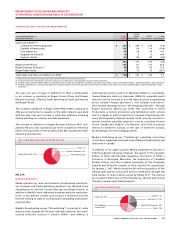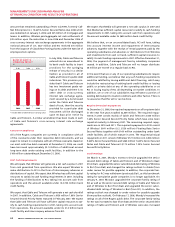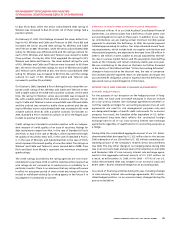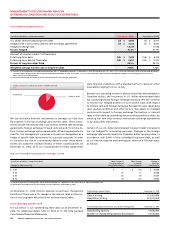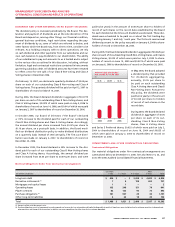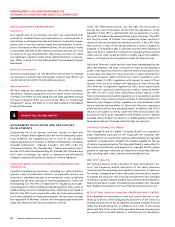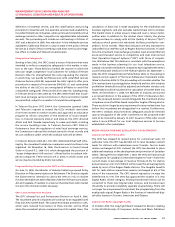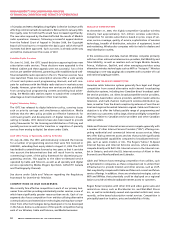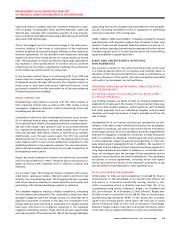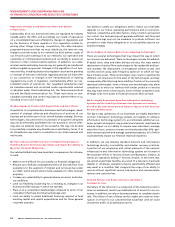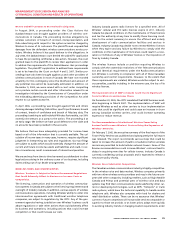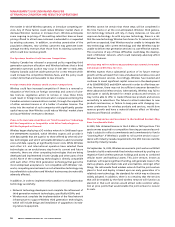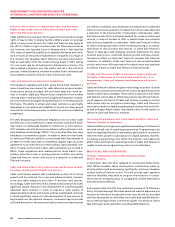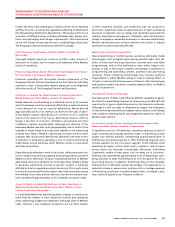Rogers 2006 Annual Report Download - page 55
Download and view the complete annual report
Please find page 55 of the 2006 Rogers annual report below. You can navigate through the pages in the report by either clicking on the pages listed below, or by using the keyword search tool below to find specific information within the annual report.
51
RO GER S CO MMU NIC AT ION S IN C . 20 0 6 ANN UA L RE POR T
MANAGEMENT’S DISCUSSION AND ANALYSIS
OF FINANCIAL CONDITION AND RESULTS OF OPERATIONS
definition of essential service, and the classifications and pricing
principles for essential and non-essential services made available by
incumbent telephone companies, cable carriers and competitive local
exchange carriers to other competitors at regulated rates (wholesale
services). The proceeding will include an oral hearing in October of
2007 and a decision in 2008. Any reduction in the wholesale services
available to Cable and Telecom or any increase in the prices of those
services as a result of this proceeding could have a serious and nega-
tive effect on Cable and Telecom’s business plan.
Com petitive Safeguards
Starting in late 2002, the CRTC issued a series of decisions that were
intended to enforce competitive safeguards in the market in rela-
tion to the ILECs. These decisions limited the manner in which the
ILECs can target competitors’ local customers for winback (Telecom
Decision 2002-73), strengthened the rules regulating the manner
in which they can bundle tariffed services with untariffed services
(Telecom Decision 2002-58), suspended the ILECs’ rights to offer price
promotions in respect of local services (PN 2003-1.1) and constrained
the ability of the ILECs to use unregulated affiliates to avoid the
competitive safeguards (Telecom Decision 2002-76). Subsequently,
in Telecom Decision CRTC 2005-25, the CRTC determined that incum-
bent local exchange carrier promotions in the local wireline market
are permitted, subject to a number of competitive safeguards.
In Telecom Decision CRTC 2004-4, the Commission granted Cable
and Telecom’s request to extend the ILECs’ winback restrictions
from three months to twelve months and approved an education
program to inform consumers of the existence of local competi-
tion. In Telecom Decisions 2004-21 and 2004-22, the CRTC directed
Aliant and Bell Canada respectively to cease and desist violating
the service bundling rules. In Telecom Decision CRTC 2006-15;
Forbearance from the regulation of retail local exchange services,
the Commission reduced the winback period to three months and
set out conditions under which the winback rules will be lifted.
In Telecom Decision 2005-28-1, the CRTC determined that VoIP offer-
ings by the incumbent telephone companies would continue to be
regulated. On November 16, 2006, the Governor in Council issued
Order in Council P.C. 2006-1314, which deregulated the provision of
“access-independent VOIP services” offered by the incumbent tele-
phone companies. These services are in areas in which access and
service may be provided by distinct providers.
Proposed Policy Direction to the CRTC on Telecommunications
On June 13, 2006, the Minister of Industry tabled a proposed Policy
Direction on Telecommunications in Parliament. The Direction signals
the Government’s intention to direct the CRTC to rely on market
forces to the maximum extent feasible under the Telecommunications
Act and regulate, if needed, in a manner that interferes with market
forces to the minimum extent necessary.
CRTC Local Forbearance Decision
The CRTC released its Local Forbearance Decision on April 6, 2006.
The incumbent phone companies will continue to be regulated until
they lose 25% market share. The customer winback prohibition rules,
which were reduced from twelve to three months, will be lifted
when the incumbent phone companies lose 20% market share. The
calculation of share loss is made separately for the residential and
business segments, and also excludes market share lost to wireless.
The market share in urban areas is measured over a census metro-
politan area. In addition to the market share criteria, the phone
companies have to comply with all the Quality of Service (“QoS”)
indicators which govern the wholesale facilities provided to com-
petitors, for six months. These QoS indicators are very important to
unbundled loop resellers such as Rogers Business Solutions. In addi-
tion, the incumbent local exchange providers must provide Ethernet
access and transport service to competitors and must interconnect
their Operations Support Systems (“OSS”) with those of competi-
tors. We believe that this decision is consistent with the assumptions
made in the business planning for our local telephone service.
Canada’s incumbent telephone companies have appealed the CRTC’s
Local Forbearance Decision to the Federal Cabinet. On September 1,
2006, the CRTC released Telecom Public Notice 2006-12, Proceeding to
reassess certain aspects of the local forbearance framework estab-
lished in Decision 2006-15. The proceeding will consider whether the
25% market share loss deregulation threshold and the 20% winback
prohibition threshold should be adjusted and whether wireless-only
households should be included in the calculation of market share loss
levels. On December 11, 2006, the Minister of Industry announced
a proposed decision in the appeal of the CRTC’s forbearance deci-
sion. The proposed decision would deregulate the incumbent phone
companies once a facilities-based competitor begins offering service.
There would no longer be any requirement for any market share loss
before the incumbents are deregulated in a market. Furthermore,
the CRTC’s winback and promotions safeguards would be removed
upon promulgation of the order. Comments on the proposed order
were to be received by January 15, 2007. Issuance of this order would
make it more difficult for our local telephone services to become
established in the marketplace.
MEDIA REGULATION AND REGULATORY DEVELOPMENTS
Com mercial Radio Policy 20 06
The CRTC has released its revised policy for commercial radio. Of
particular note, the CRTC has decided not to raise Canadian content
levels for stations with mainstream music formats. Cancon levels
remain unchanged at 35%. Instead, the CRTC has decided to place
additional emphasis on the development and promotion of Canadian
talent. Taking effect on September 1, 2007, the CRTC will raise annual
contributions for Canadian Content Development (“CCD”) from their
current levels. A percentage of revenue formula (0.5% for station
annual revenue over $1.25 million) will increase the annual payments
made by most of the Rogers Radio stations. The tangible benefits
test for radio station acquisitions remains unchanged at 6% of the
value of the transaction. The CRTC denied requests to increase the
benefits test to 10%. The CRTC has approved the creation of a new
Digital Radio licence category. Existing transitional licences can be
converted to these new Digital radio licences, and licencees have
the ability to provide completely separate programming. There will
no longer be a requirement to simulcast the programming from the
analog radio signal. Rogers Radio is the licencee of transitional digi-
tal radio licences in Toronto, Vancouver and Ottawa.
Com mercial Radio Copyright Tariffs
In October 2005, the Copyright Board released its decision relating
to the SOCAN (Society of Composers, Authors and Music Publishers


